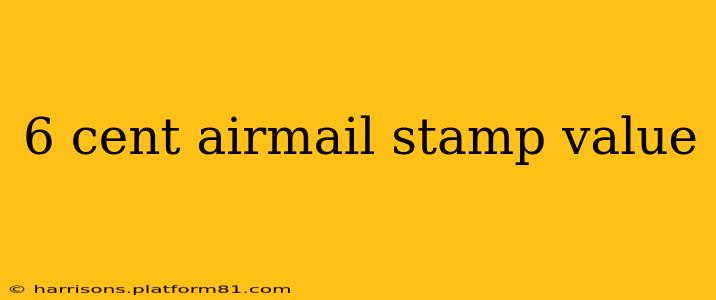The value of a 6-cent airmail stamp hinges on several factors, making a definitive answer impossible without examining the specific stamp. This guide will explore the key elements influencing a 6-cent airmail stamp's worth and help you determine its potential value. We'll delve into the history of these stamps, the factors affecting their condition, and where to find more information on your specific find.
What Makes a 6-Cent Airmail Stamp Valuable?
Several factors significantly influence the value of a 6-cent airmail stamp:
-
Issue Date and Design: Different 6-cent airmail stamps were issued throughout history, each with its unique design and historical significance. Rarer designs and issues from specific years will generally command higher prices. Collectors often focus on specific eras or artistic styles, driving demand for certain stamps.
-
Condition: The condition of the stamp is paramount. Uncirculated or mint condition stamps, free from tears, creases, or significant blemishes, are considerably more valuable than those showing significant wear and tear. Grading services, like the ones offered by the American Philatelic Society, provide detailed assessments of a stamp's condition, further influencing its worth.
-
Rarity: The rarity of a specific 6-cent airmail stamp directly affects its value. Limited print runs, misprints, or stamps with unique errors can significantly increase their worth among collectors. These rare variations can become highly sought-after items in the philatelic market.
-
Cancellation: The cancellation mark on the stamp, showing its prior use, can actually affect value. Some collectors prefer stamps with crisp, clear cancellations, while others might prefer uncancelled (mint) examples. The type of cancellation can also be a factor for specialists.
Identifying Your 6-Cent Airmail Stamp
To accurately determine the value of your 6-cent airmail stamp, you need to identify its specific issue date and design. This usually involves examining details such as:
- The imagery on the stamp: What is depicted? Is it an airplane, a patriotic symbol, or something else?
- The color of the stamp: Different issues used various colors.
- The perforation: The spacing between the stamp's perforations can be a key identifier.
Using online resources like stamp catalogs (many are available digitally) and websites dedicated to stamp collecting can assist in identifying your stamp precisely. Comparing your stamp to images in these resources will help you narrow down its potential issue date and design.
Where to Find More Information and Sell Your Stamps
Several resources can help you learn more about your 6-cent airmail stamp and its potential value:
-
Online Stamp Catalogs: Several websites offer comprehensive catalogs with images and information on various stamps. These catalogs often include valuation guides, though keep in mind that values are estimates and can vary based on condition and market demand.
-
Stamp Collecting Societies: Joining a local or national stamp collecting society can provide access to experienced collectors and experts who can help identify and appraise your stamps.
-
Stamp Dealers and Auction Houses: Professional stamp dealers and auction houses can provide expert appraisals and assist with selling your stamps. They are familiar with the market and can offer guidance on pricing and potential buyers.
How Much is a 6-Cent Airmail Stamp Worth?
Unfortunately, a precise value for a 6-cent airmail stamp can't be provided without seeing the stamp itself. The range in value is quite vast, from a few dollars for common, well-used stamps to hundreds or even thousands of dollars for rare or exceptionally well-preserved examples.
What are some other types of 6-cent stamps?
While the question focused on airmail, it's worth noting that 6-cent stamps were issued for general postage as well. These would not feature the airmail insignia and their value would be assessed independently based on the same factors discussed above (date, design, condition, and rarity).
By carefully examining your stamp and utilizing the resources mentioned above, you can confidently determine its potential value and appreciate its place in philatelic history. Remember, a professional appraisal is always recommended for high-value stamps.
